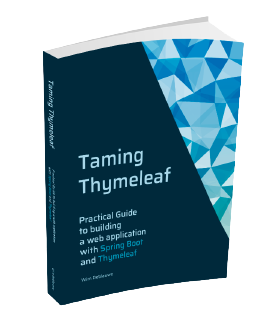<parent>
<groupId>org.springframework.boot</groupId>
<artifactId>spring-boot-starter-parent</artifactId>
<version>2.3.0.RELEASE</version>
<relativePath/> <!-- lookup parent from repository -->
</parent>Taming Thymeleaf 2.0 release
My book Taming Thymeleaf has been updated for Java 17, Spring Boot 2.6 and Tailwind CSS 3.0. This update is free for all Leanpub readers.
What exactly was updated?
The main motivation for this update was the release of Tailwind CSS 3.0. The Just-In-Time compiler that is now the default changes things a bit in the setup and I wanted to avoid that people would get stuck following along with the book now that Tailwind CSS 3.0 is the default version.
Next to that, the following dependencies have also been updated:
-
Java 17: Java 17 is currently the version that new projects should use, so it makes sense for this book to baseline on that. I did not update code snippets to use exclusive Java 17 syntax, so if need be, you can run everything on Java 11 as well.
-
Spring Boot 2.6: This is the current latest version of Spring Boot.
-
AlpineJS 3.7: Everything was compatible with the version the book used before (2.8.0).
-
Node 16 and NPM 8: These are the current versions so it made sense to align with those.
How to update my own application?
If you have an application based on the previous version of the book, then you can bring it up-to-date like this:
Update to Spring Boot 2.6
Replace:
with:
<parent>
<groupId>org.springframework.boot</groupId>
<artifactId>spring-boot-starter-parent</artifactId>
<version>2.6.2</version>
<relativePath/> <!-- lookup parent from repository -->
</parent>Note how the .RELEASE part is no longer there.
If you have a custom version of thymeleaf-layout-dialect, then remove the specific version.
Spring Boot defines a compatible version.
So replace:
<dependency>
<groupId>nz.net.ultraq.thymeleaf</groupId>
<artifactId>thymeleaf-layout-dialect</artifactId>
<version>${thymeleaf-layout-dialect.version}</version>
</dependency>with:
<dependency>
<groupId>nz.net.ultraq.thymeleaf</groupId>
<artifactId>thymeleaf-layout-dialect</artifactId>
</dependency>And remove the property:
<thymeleaf-layout-dialect.version>2.4.1</thymeleaf-layout-dialect.version>Update to Java 17
Update java.version property in the pom.xml:
<java.version>17</java.version>Be sure to also use a Java 17 JDK when doing this change.
When using SDKMAN!, you can do this with this command:
sdk install java 17.0.1-temUpdate frontend-maven-plugin
Replace:
<frontend-maven-plugin.version>1.10.0</frontend-maven-plugin.version>
<frontend-maven-plugin.nodeVersion>v14.7.0</frontend-maven-plugin.nodeVersion>
<frontend-maven-plugin.npmVersion>6.14.11</frontend-maven-plugin.npmVersion>with:
<frontend-maven-plugin.version>1.12.0</frontend-maven-plugin.version>
<frontend-maven-plugin.nodeVersion>v16.13.1</frontend-maven-plugin.nodeVersion>
<frontend-maven-plugin.npmVersion>8.1.2</frontend-maven-plugin.npmVersion>Be sure to also update the locally installed node and npm.
How exactly depends on how you installed it.
I find it easiest to use the Node Version Manager.
Update Testcontainers
Set the Testcontainers version to 1.16.2:
<testcontainers.version>1.16.2</testcontainers.version>Update Guava
Set the Guava version to 31.0.1-jre:
<guava.version>31.0.1-jre</guava.version>Update Tailwind
Run this command to update to Tailwind 3:
npm install -D tailwindcss@latest \
@tailwindcss/forms@latest \
postcss@latest \
autoprefixer@latestNext, update the configuration file tailwind.config.js.
It normally looks something like this:
const defaultTheme = require('tailwindcss/defaultTheme');
module.exports = {
purge: {
content: ['./src/main/resources/templates/**/*.html']
},
darkMode: false, // or 'media' or 'class'
theme: {
extend: {
fontFamily: {
sans: ['Inter var', ...defaultTheme.fontFamily.sans],
},
}
},
variants: {
extend: {},
},
plugins: [
require('@tailwindcss/forms')
]
};Change it to be like this:
const defaultTheme = require('tailwindcss/defaultTheme');
module.exports = {
content: ['./src/main/resources/templates/**/*.html',
'./src/main/resources/templates/**/*.svg'],
theme: {
extend: {
fontFamily: {
sans: ['Inter var', ...defaultTheme.fontFamily.sans],
},
}
},
plugins: [
require('@tailwindcss/forms')
]
};If you did other customizations, you will need to copy them over as well. See the Upgrade guide for more information about how to upgrade from Tailwind CSS 2.0 to 3.0.
Upgrade Gulp script
The Gulp script should be changed to this:
const gulp = require('gulp');
const babel = require("gulp-babel");
const watch = require('gulp-watch');
const browserSync = require('browser-sync').create();
const environments = require('gulp-environments');
const uglifycss = require('gulp-uglifycss');
const terser = require('gulp-terser');
const postcss = require('gulp-postcss');
const purgecss = require('gulp-purgecss');
const production = environments.production;
gulp.task('watch', () => {
browserSync.init({
proxy: 'localhost:8080',
});
gulp.watch(['src/main/resources/**/*.html'], gulp.series('copy-html+css-and-reload'));
gulp.watch(['src/main/resources/**/*.svg'], gulp.series('copy-svg+css-and-reload'));
gulp.watch(['src/main/resources/**/*.css'], gulp.series('copy-css-and-reload'));
gulp.watch(['src/main/resources/**/*.js'], gulp.series('copy-js-and-reload'));
});
gulp.task('copy-html', () =>
gulp.src(['src/main/resources/**/*.html'])
.pipe(gulp.dest('target/classes/'))
);
gulp.task('copy-css', () =>
gulp.src(['src/main/resources/**/*.css'])
.pipe(postcss())
.pipe(production(uglifycss()))
.pipe(gulp.dest('target/classes/'))
);
gulp.task('copy-js', () =>
gulp.src(['src/main/resources/**/*.js'])
.pipe(babel())
.pipe(production(terser()))
.pipe(gulp.dest('target/classes/'))
);
gulp.task('copy-svg', () => gulp.src(['src/main/resources/**/*.svg'])
.pipe(gulp.dest('target/classes/')));
// When the HTML or SVG changes, we need to copy the CSS also because
// the Tailwind CSS JIT compiler might generate new CSS
gulp.task('copy-html+css-and-reload', gulp.series('copy-html', 'copy-css', reload));
gulp.task('copy-css-and-reload', gulp.series('copy-css', reload));
gulp.task('copy-js-and-reload', gulp.series('copy-js', reload));
gulp.task('copy-svg+css-and-reload', gulp.series('copy-svg', 'copy-css', reload));
gulp.task('build', gulp.series('copy-html', 'copy-css', 'copy-js', 'copy-svg'));
gulp.task('default', gulp.series('watch'));
function reload(done) {
browserSync.reload();
done();
}The reason for this change is that Tailwind CSS 3.0 now only generates the classes that are actually used in the HTML. As a consequence, we need to re-generate the CSS when the HTML or the CSS changes.
Upgrade AlpineJS
Replace:
<script src="https://cdn.jsdelivr.net/gh/alpinejs/alpine@v2.8.0/dist/alpine.js" defer></script>with:
<script src="https://unpkg.com/alpinejs@3.7.0/dist/cdn.min.js" defer></script>If you are using x-cloak with Alpine, you can add it to your application.css like this:
@tailwind base;
@tailwind components;
@tailwind utilities;
@layer utilities {
[x-cloak] {
display: none;
}
}Enable cache busting
Add these properties to your application-local.properties:
spring.web.resources.chain.strategy.content.enabled=true
spring.web.resources.chain.strategy.content.paths=/**This will enable cache busting for the JavaScript and CSS files.
It found that it makes the live reload experience a lot more reliable.
It might also be good to have this for production as well, so you could add it to application.properties if you want.
Conclusion
It is important to stay up do date with your dependencies to avoid getting stuck on older versions where everybody is afraid to update them, even in the light of security vulnerabilities. The information above should give you all the information you need for the update.
See Taming Thymeleaf for more information about the book and the links to Leanpub and Lulu to buy it.
If you have any questions or remarks, feel free to post a comment at GitHub discussions.

